Consumer Medicine Information (CMI) summary
The
full CMI on the next page has more details. If you are worried about using this medicine,
speak to your doctor or pharmacist.
This medicine is new or being used differently. Please report side effects. See the
full CMI for further details.
1. Why am I using REVESTIVE?
REVESTIVE contains the active ingredient teduglutide. REVESTIVE is used to treat adults
and children 2 years of age and above with Short Bowel Syndrome who need additional
nutrition or fluids from intravenous feeding (parenteral support).
2. What should I know before I use REVESTIVE?
Do not use if you have ever had an allergic reaction to REVESTIVE or any of the ingredients
listed at the end of the CMI.
Talk to your doctor if you have any other medical conditions, take any other medicines,
or are pregnant or plan to become pregnant or are breastfeeding.
3. What if I am taking other medicines?
Some medicines may interfere with REVESTIVE and affect how it works.
4. How do I use REVESTIVE?
The recommended daily dose is 0.05 mg per kg body weight once per day, given under
the skin. The dose will be prescribed as mL of solution. Your doctor will choose the
dose that is right for you depending on your body weight.
Follow all directions given to you by your doctor or pharmacist carefully.
5. What should I know while using REVESTIVE?
|
Things you should do
|
Remind any doctor or dentist you visit that you are using REVESTIVE. If you become
pregnant while using this medicine, tell your doctor immediately.
|
|
Things you should not do
|
Do not stop using REVESTIVE or change the dosage without checking with your doctor.
|
|
Driving or using machines
|
Be careful driving or operating machinery until you know how REVESTIVE affects you.
|
|
Looking after your medicine
|
Keep the REVESTIVE in a cool dry place where the temperature stays below 25°C. Do
not freeze it. after reconstitution, the solution should be used immediately.
|
6. Are there any side effects?
Common side effects include cold or flu-like symptoms, decreased appetite, headache,
stomach pain, bloated stomach, flatulence, nausea, vomiting, swelling of stoma, trouble
sleeping, cough, urinary tract infection, reddening, pain or swelling at the site
of the injection. Serious side effects include swelling of hands and/or feet; infection
of the sinuses, throat, airways or lungs; chest pain; tiredness, shortness of breath,
with or without swelling of ankles or legs.
This medicine is subject to additional monitoring. This will allow quick identification
of new safety information. You can help by reporting any side effects you may get.
You can report side effects to your doctor, or directly at www.tga.gov.au/reporting-problems .
Active ingredient(s): teduglutide
Full Consumer Medicine Information (CMI)
This leaflet provides important information about using REVESTIVE. You should also speak to your doctor or pharmacist if you would like further information
or if you have any concerns or questions about using REVESTIVE.
Information specific to children is described under the heading “Children”. General
information for adults is also applicable to children.
The information in this leaflet was last updated on the date listed in 'Section 7.
Product details'. More recent information on the medicine may be available. You should
ensure that you speak to your pharmacist or doctor to obtain the most up to date information
on this medicine.
Where to find information in this leaflet:
1. Why am I using REVESTIVE?
REVESTIVE contains the active ingredient teduglutide. REVESTIVE improves the absorption of nutrients and fluid from your remaining gut.
REVESTIVE is used to treat adults and children 2 years of age and above with Short
Bowel Syndrome who need additional nutrition or fluids from intravenous feeding (parenteral
support). Short Bowel Syndrome is a disorder arising from an inability to absorb food
nutrients and fluid across the gastrointestinal tract (gut). It is often caused by
surgical removal of all or part of the small intestine.
2. What should I know before I use REVESTIVE?
Warnings
Do not use REVESTIVE if you:
are allergic to teduglutide, or any of the ingredients listed at the end of this leaflet.
Always check the ingredients to make sure you can use this medicine.
have or suspected to have cancer.
have had cancer in the gastrointestinal tract, including liver, gallbladder or bile
ducts, and pancreas within the last five years.
Check with your doctor if you:
have or had any these medical conditions: severely decreased liver function; certain
cardiovascular diseases (affecting the heart and/or blood vessels) such as high blood
pressure or a weak heart; decreased kidney function; other severe diseases that are
not well controlled
take any medicines for any other condition.
During treatment, you may be at risk of developing certain side effects. It is important
you understand these risks and how to monitor for them. See additional information
under Section
6. Are there any side effects?
Pregnancy and breastfeeding
Check with your doctor if you are pregnant or intend to become pregnant.
Talk to your doctor if you are breastfeeding or intend to breastfeed.
Children
REVESTIVE should not be used in children under 2 years of age.
REVESTIVE should not be given for children weighing less than 10 kg.
Medical check-ups for children before and during treatment
Before starting treatment with this medicine, your child will have a test done to
see if there is blood in the stool. Your child will also have a colonoscopy done (a
procedure to see inside their colon and rectum to check for the presence of polyps
(small abnormal growths) and have them removed) if they have unexplained blood in
their bowel movements (stools). If polyps are found before treatment with REVESTIVE,
the doctor will decide whether your child should use this medicine.
REVESTIVE should not be used if a cancer is detected during colonoscopy.
The doctor will perform further colonoscopies if your child continues treatment with
REVESTIVE.
Medical check-ups for adults before and during treatment
If you are an adult, before you start treatment with this medicine, your doctor will
need to perform a colonoscopy (a procedure to see inside your colon and rectum) to
check for the presence of polyps (small abnormal growths) and remove them. In children
and adolescents, the doctor will first check for blood in the stool before they decide
to perform a colonoscopy
It is recommended that your doctor performs these examinations once a year during
the first two years after starting treatment, and then at a minimum of five-year intervals.
If polyps are found either before or during your treatment with REVESTIVE, your doctor
will decide whether you should continue using this medicine.
Your doctor may decide to perform upper gastrointestinal endoscopy or other imaging
before and during the treatment.
REVESTIVE should not be used if a cancer is detected during your colonoscopy.
3. What if I am taking other medicines?
Tell your doctor or pharmacist if you are taking any other medicines, including any
medicines, vitamins or supplements that you buy without a prescription from your pharmacy,
supermarket or health food shop.
REVESTIVE may affect how other medicines are absorbed from the gut and therefore how
well they work. Your doctor may have to change your dose of other medicines.
Your doctor and pharmacist have more information on medicines to be careful with or
avoid while using this medicine.
4. How do I use REVESTIVE?
How much to use
Children (2 years of age and above) and adults
The recommended daily dose is 0.05 mg per kg body weight once per day, given under
the skin. The dose will be prescribed as mL of solution.
Your doctor will choose the dose that is right for you depending on your body weight.
Your doctor will tell you which dose to inject. If you are not sure, ask your doctor,
pharmacist or nurse.
Follow the instructions provided and use REVESTIVE until your doctor tells you to
stop.
It is strongly recommended that every time you/your child receives a dose of REVESTIVE,
the name and lot number of the product are recorded in order to maintain a record
of the lots used.
When to use REVESTIVE
REVESTIVE is injected under the skin (subcutaneously) once daily.
How to use REVESTIVE
The injection can be self-administered or given by another person, for example your
doctor, your caregiver or your home nurse.
If you are self injecting the medicine, you must receive adequate training by your
doctor or nurse. You will find detailed instructions for preparing and injecting the
medicine at the end of this leaflet.
If you forget to use REVESTIVE
REVESTIVE should be used regularly at the same time each day. If you miss your dose
at the usual time, take it as soon as possible on that day.
Never use more than one injection in the same day.
Do not inject a double dose to make up for the dose that you missed.
If you use too much REVESTIVE
If you think that you have used too much REVESTIVE, you may need urgent medical attention.
You should immediately:
phone the Poisons Information Centre
(by calling
13 11 26 in Australia; 0800 POISON or 0800 764766 in New Zealand), or
contact your doctor, or
go to the Emergency Department at your nearest hospital.
You should do this even if there are no signs of discomfort or poisoning.
5. What should I know while using REVESTIVE?
Things you should do
If you are about to be started on any new medicine, remind your doctor and pharmacist
that you are using REVESTIVE.
Tell any other doctors, dentists, and pharmacists who treat you that you are using
this medicine.
If you become pregnant while using this medicine, tell your doctor immediately.
Keep all of your doctor's appointments so that your progress can be checked.
Children
It is recommended that your child’s doctor tests for hidden blood in the stool every
year while your child is receiving treatment with REVESTIVE. Colonoscopy is recommended
for all children after 1 year of treatment and after every 5 years thereafter while
on continuous treatment with REVESTIVE, and if they have new or unexplained blood
in stool. (See
'Medical check-ups for children before and during treatment' in section 2. What should I know before I use REVESTIVE?
Adult
It is recommended that your doctor performs examinations to check for the presence
of polyps once a year during the first two years after starting treatment, and then
at a minimum of five-year intervals. (See '
Medical check-ups for adults before and during treatment' in section 2. What should I know before I use REVESTIVE?
Your doctor will take special care and monitor your small bowel function and monitor
for signs and symptoms indicating problems with your gallbladder, bile ducts and pancreas.
Your doctor may decide to perform upper gastrointestinal endoscopy or other imaging.
Remind any doctor or dentist you visit that you are using REVESTIVE.
Things you should not do
Do not stop using REVESTIVE or lower the dosage without checking with your doctor.
If you stop using it suddenly, your fluid balance may change.
Driving or using machines
Be careful before you drive or use any machines or tools until you know how REVESTIVE
affects you.
REVESTIVE may cause dizziness in some people. If this happens to you, do not drive
or use machines until you feel better.
Looking after your medicine
Store it in a cool dry place where the temperature stays below 25°C. Do not freeze
it.
After reconstitution, the solution should be used immediately. However, chemical and
physical stability has been demonstrated for 3 hours at 25°C.
Do not store it in the bathroom or near a sink, or in the car or on window sills.
Do not use this medicine after the expiry date.
Keep it where young children cannot reach it.
Getting rid of any unwanted medicine
If you no longer need to use this medicine or it is out of date, take it to any pharmacy
for safe disposal.
6. Are there any side effects?
All medicines can have side effects. If you do experience any side effects, most of
them are minor and temporary. However, some side effects may need medical attention.
See the information below and, if you need to, ask your doctor or pharmacist if you
have any further questions about side effects. In general, the side effects in children
and adolescents are similar to those seen in adults.
Less serious side effects
|
Less serious side effects
|
What to do
|
|
Stomach pain
Nausea
Bloated stomach
Vomiting
Flatulence
Urinary tract infection
Cold or flu-like symptoms
Any infection of the sinuses, throat, airways or lungs
Decreased appetite
Headache
Trouble sleeping, anxiety
Cough
Reddening, pain or swelling at the site of the injection
Swelling of stoma (an artificial opening for waste removal)
|
Speak to your doctor if you have any of these less serious side effects and they worry
you.
|
Serious side effects
|
Serious side effects
|
What to do
|
|
Swelling of hands and/or feet
Any infection of the sinuses, throat, airways or lungs (respiratory tract infection)
Chest pain
Fainting
Tiredness, shortness of breath, with or without swelling of ankles or legs (congestive
heart failure)
Allergic reaction which may result in a rash or more rarely to a sharp drop in blood
pressure, difficulty breathing, and hives/itching (anaphylactic reaction)
Severe stomach ache, fever (inflammation of the pancreas)
Severe stomach ache, vomiting, constipation (blockage of the bowel)
Yellowing of the skin and the whites in the eyes, itching, dark urine and light-coloured
stools or pain in the upper right side or middle of the stomach area (reduced flow
of bile from the gallbladder and/or inflammation of the gallbladder)
Blood in stool (this could be due to small abnormal growth (polyps) in the bowels
or stomach)
|
Call your doctor straight away, or go straight to the Emergency Department at your
nearest hospital if you notice any of these serious side effects.
|
Tell your doctor or pharmacist if you notice anything else that may be making you
feel unwell.
Other side effects not listed here may occur in some people.
Reporting side effects
After you have received medical advice for any side effects you experience, you can
report side effects to the Therapeutic Goods Administration online at
www.tga.gov.au/reporting-problems . By reporting side effects, you can help provide more information on the safety of
this medicine.
Always make sure you speak to your doctor or pharmacist before you decide to stop
taking any of your medicines.
7. Product details
This medicine is only available with a doctor's prescription.
What REVESTIVE contains
|
Active ingredient
(main ingredient)
|
Teduglutide
|
|
Other ingredients
(inactive ingredients)
|
Histidine, mannitol, monobasic sodium phosphate monohydrate, dibasic sodium phosphate
heptahydrate.
The solvent is sterile water for injections.
|
Do not take this medicine if you are allergic to any of these ingredients.
What REVESTIVE looks like
REVESTIVE (AUST R 274911) is a powder and solvent for solution for injection (5 mg
powder in vial, 0.5 mL solvent in pre-filled syringe). The powder is white and the
solvent is clear and colourless.
One vial of powder contains 5 mg of teduglutide. After reconstitution, each vial contains
5 mg teduglutide in 0.5 mL of solution, corresponding to a concentration of 10 mg/mL.
Each pack contains 28 vials with powder and 28 pre-filled syringes with solvent.
Who distributes REVESTIVE
Takeda Pharmaceuticals Australia Pty Ltd
Level 39, 225 George Street
Sydney, NSW 2000
Australia
Telephone: 1800 012 612
This leaflet was prepared in January 2024.
REVESTIVE® is a registered trademark of Shire-NPS Pharmaceuticals, Inc., a Takeda company. TAKEDA® and the TAKEDA® Logo are registered trademarks of Takeda Pharmaceutical Company Limited.
8. Instructions for preparing and injecting REVESTIVE
Important information
Please read these instructions before you start using REVESTIVE. If it is your child
who is using the medicine, the word 'you' in this leaflet means your child.
REVESTIVE is for injection under the skin (subcutaneous injection). Do not inject
it into a vein or muscle.
After reconstitution, the solution should be used within 3 hours.
Do not use REVESTIVE if you notice that the solution is cloudy or contains particulate
matter.
Dispose of all needles and syringes in a sharps disposal container.
Materials in the REVESTIVE pack:
28 vials with 5 mg teduglutide as a powder
28 pre-filled syringes with solvent
Materials needed but not included in the REVESTIVE pack:
reconstitution needles (size 22G, length 1½" (0.7 x 40 mm))
1 mL injection syringes (with scale intervals of 0.02 mL or smaller). For children,
up to a 1 mL (or smaller) injection syringe (with scale intervals of 0.01mL or smaller)
may be used
thin injection needles for subcutaneous injection (for example, size 26G, length 5/8"
(0.45 x 16 mm), or smaller needles for children, as appropriate)
alcohol wipes
alcohol swabs
a puncture-proof container for safe disposal of the used syringes and needles
NOTE: Before you start, make sure you have a clean work surface and that you have
washed your hands before proceeding.
1. Prepare the pre-filled syringe
Once you have all the materials ready, you need to prepare the pre-filled syringe.
The following procedure shows how you do this.
1.1 Take the pre-filled syringe containing the solvent and flip off the top part of
the white plastic cap on the pre-filled syringe so that it is ready for the reconstitution
needle to be attached.
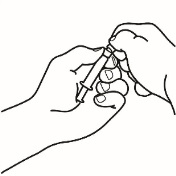
1.2 Attach the reconstitution needle (22G, 1½" (0.7 x 40 mm)) to the pre-filled syringe
by screwing it on in a clockwise direction.
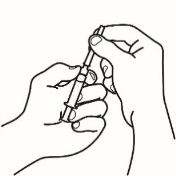
2. Dissolve the powder
Now you are ready to dissolve the powder with the solvent.
2.1 Remove the green flip-off button from the powder vial, wipe the top with an alcohol
wipe and allow it to dry. Do not touch the top of the vial.

2.2 Uncap the reconstitution needle on the pre-filled syringe with solvent without
touching the tip of the needle.
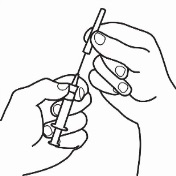
2.3 Taking the powder vial, insert the reconstitution needle attached to the pre-filled
syringe into the centre of the rubber stopper and gently push the plunger all the
way down to inject all the solvent into the vial.
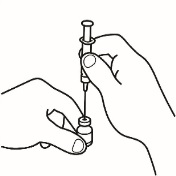
2.4 Leave the reconstitution needle and empty syringe in the vial. Let the vial rest
for about 30 seconds.
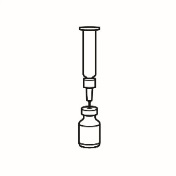
2.5 Gently roll the vial between your palms for about 15 seconds. Then gently turn
the vial upside-down once with the reconstitution needle and empty syringe still in
the vial.
Note: Do not shake the vial. Shaking the vial may produce foam, which makes it difficult
to extract the solution from the vial.
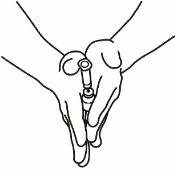
2.6 Let the vial rest for about 2 minutes.

2.7 Observe the vial for any undissolved powder. If any powder remains, repeat steps
2.5 and 2.6.
Do not shake the vial. If there is still some undissolved powder, discard the vial
and start the preparation again from the beginning with a new vial.
NOTE: The final solution should be clear. If the solution is cloudy or contains particulate
matter, do not inject it.
NOTE: Once prepared, the solution should be used immediately. It should be kept below
25°C and maximum storage time is 3 hours.
3. Prepare the injection syringe
3.1 Remove the reconstitution syringe from the reconstitution needle which is still
in the vial and discard the reconstitution syringe.
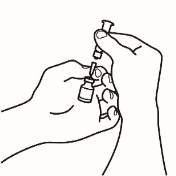
3.2 Take the injection syringe and attach it to the reconstitution needle which is
still in the vial.
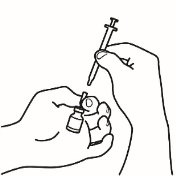
3.3 Turn the vial upside down, slide the tip of the reconstitution needle close to
the stopper and allow all the medicine to fill the syringe by pulling the plunger
back gently.

NOTE: If your doctor has told you that you need two vials, prepare a second pre-filled
syringe with solvent and a second powder vial as shown in the main steps 1 and 2.
Withdraw the solution from the second vial into the same injection syringe by repeating
step 3.
3.4 Remove the injection syringe from the reconstitution needle leaving the needle
in the vial. Discard the vial and reconstitution needle together into the sharps disposal
container.
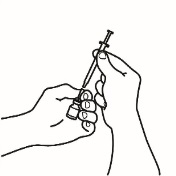
3.5 Take the injection needle (26G, 5/8" (0.45 x 16 mm)), but do not remove the plastic
needle cap. Attach the needle to the injection syringe containing the medicine.
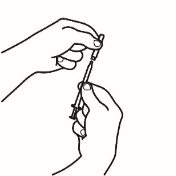
3.6 Check for air bubbles. If air bubbles are present, gently tap the syringe until
they rise to the top. Then gently push up the plunger to expel the air.

3.7 Your dose in mL has been calculated by your doctor. Expel any excessive volume
from the syringe with the needle cap still on until your dose is reached.
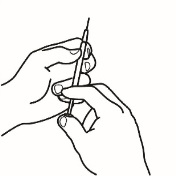
4. Inject the solution
4.1 Find an area on your belly, or if you have pain or hardening of the tissue on
your belly, on your thigh where it is easy for you to give the injection.
NOTE: Do not use the same area each day for each injection - rotate sites each day
(use upper, lower, and left and right side of your belly) to avoid discomfort. Do
not inject into the side if it has a stoma (an artificial opening for waste removal).
Avoid areas that are inflamed, swollen, scarred or covered by a mole, birthmark or
other lesion.
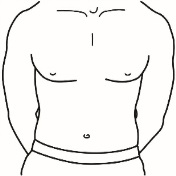

4.2 Clean the intended site of injection on your skin with an alcohol swab, using
a circular motion, working outwards. Allow the area to air-dry.
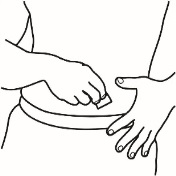
4.3 Remove the plastic cap from the needle of the prepared injection syringe. Gently
grasp the cleaned skin at the injection site with one hand. With the other hand, hold
the syringe as you would with a pencil. Bend your wrist back and quickly insert the
needle at a 45° angle.
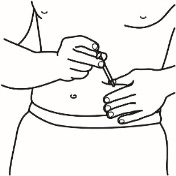
4.4 Pull back the plunger slightly. If you see any blood in the syringe, withdraw
the needle and replace the needle on the injection syringe with a clean one of the
same size. You can still use the medicine that is already in the syringe. Try to inject
in another place in the cleaned skin area.
4.5 Inject the medicine slowly by pushing steadily on the plunger until all the medicine
is injected and the syringe is empty.
4.6 Pull the needle straight out of the skin and discard the needle and syringe together
into the sharps disposal container. A small amount of bleeding may occur. If necessary,
press gently on the injection site with an alcohol swab or 2x2 gauze until any bleeding
has stopped.
4.7 Dispose of all needles and syringes in a sharps disposal container.